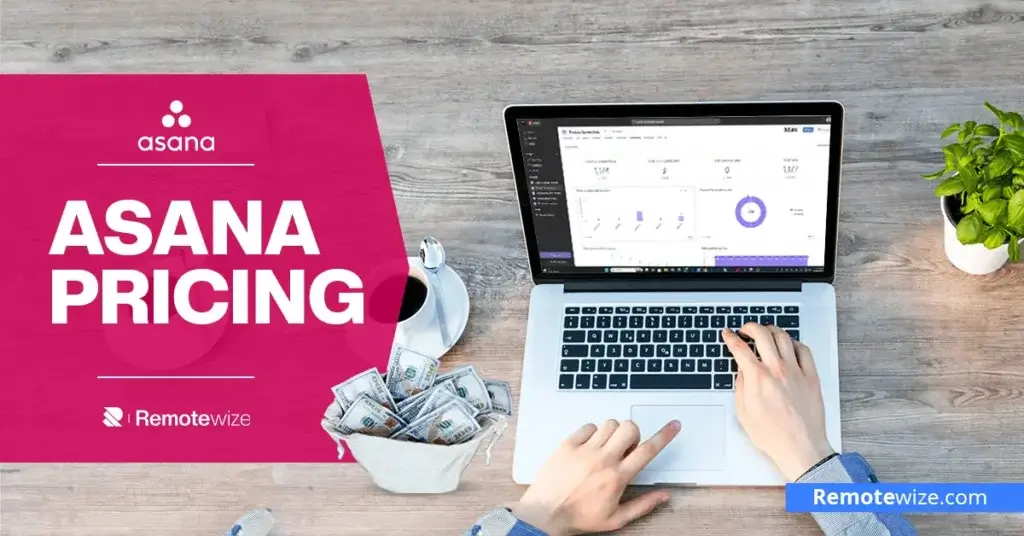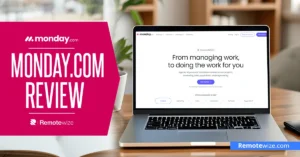Asana is one of the most popular project management software tools today. This task management platform is loved for its robust collaboration features, ease of use, and scalability. However, with its popularity and the many solutions that the platform brings to the table, one might wonder — how much will it set you back?
In this Asana pricing guide, we’ll explain the different plans in detail, look at their main features, and show how each tier fits with different team needs and budgets. More importantly, you’ll discover why thousands of teams trust Asana to simplify project management, improve communication, and scale operations efficiently.
Key Takeaways: Asana Pricing Overview
- Asana’s free plan includes unlimited tasks, projects, basic task management, and basic views. It is perfect for individuals, freelancers, and small teams. However, expect limitations, like limited reporting and no advanced features. Start with the Asana free plan to get to know its project management capabilities.
- Asana has 4 paid plans — Starter, Advanced, Enterprise, and Enterprise+ —, with pricing starting at $13.49/user/month. The Starter and Advanced plans suit individuals and small teams, while Enterprise and Enterprise+ cater to big organizations with complex needs.
- Asana is more expensive than some project management tools like ClickUp or Trello, whose pricing starts from $7/user/month and $5/user/month, respectively. These can be great alternatives for budget-conscious teams.
Asana at a Glance: Features, Benefits, and Shortcomings
Asana is a cloud-based, all-in-one project management platform that helps teams plan, organize, and track their work. It eliminates scattered communication and spreadsheets by providing a structured way to manage tasks, deadlines, and responsibilities. Asana provides a clear framework that keeps teams aligned, accountable, and focused on delivering results. It is ideal for both startups and large enterprises.
What makes Asana stand out is its flexibility. Teams can work through list, Kanban, timeline, calendar, or dashboard views. Its powerful integrations with tools like Slack, Google Drive, and Microsoft Teams make it easy to fit into existing workflows. Marketing, product, and operations teams can use Asana daily to plan campaigns, launches, and complex projects efficiently.
However, Asana has its limitations, too. For example, some advanced features, like reporting dashboards, administrative controls, and portfolio tracking, are only available on paid plans. Also, this project management platform’s flexibility may also feel overwhelming for new users.
Taking its strengths and weaknesses into consideration, Asana offers a balance of simplicity and depth, which makes it a great option for businesses seeking scalable, structured, and transparent project management without sacrificing ease of use or team collaboration.
Benefits of Using Asana
Asana has a range of advantages that make it stand out as one of the best product management tools.
- Flexible Work Views: Unlike most tools, Asana doesn’t lock you into one project view, as you can choose from dashboard, timeline, calendar, board, and list views. This makes it flexible for different teams, meaning they can use their preferred styles at any time.
- Streamlined Project and Task Visibility: Asana offers a streamlined workspace where every task, owner, and deadline is clearly visible. This eliminates confusion and simplifies progress tracking for each task.
- Scalable For Teams Of Any Size: Asana scales as teams grow, whether they are a small startup or a large enterprise. Moreover, its flexible pricing structure and advanced features support both simple task tracking and complex portfolio management.
- Powerful Automation That Saves Time: Asana’s built-in rules and workflows reduce repetitive manual work. Thus, teams can automate task assignments, due dates, or notifications, minimizing human error.
- Robust Integrations With Popular Tools: Asana seamlessly connects with tools like Slack, Google Drive, Microsoft Teams, Zoom, and Salesforce. These integrations ensure teams don’t have to constantly switch between apps, keeping communication and collaboration smooth.
The Asana Pricing Structure Explained
Asana uses a hybrid pricing model that combines both user-based and tiered structures. Pricing is primarily calculated per user, meaning the cost increases with the number of team members. However, it’s also tiered, where each plan—Personal (free forever), Starter, Advanced, Enterprise, and Enterprise+—comes with a unique set of features, support levels, and administrative controls.
The key advantage of this pricing model is its flexibility and scalability. Small teams can start with the free or Starter plan and upgrade as their projects become more complex. Meanwhile, larger organizations can opt for Advanced or Enterprise plans to access robust reporting, automation, and security features.
What are seats in Asana?
In Asana, a “seat” refers to a paid user license on a team or organization plan. Each person who actively uses the platform and is involved in tasks such as creating, assigning, or completing tasks occupies one seat. When you purchase a paid plan, you pay for a specific number of user seats and the features associated with that plan.
However, Asana uses tiered seat packages, meaning you can’t always buy the exact number of seats your team needs. For instance, I tried to buy a subscription for a team with six members, but the available options closest to that number were for 5 seats and 10 seats. This meant I had to purchase the 10-seat option, leaving four unused.
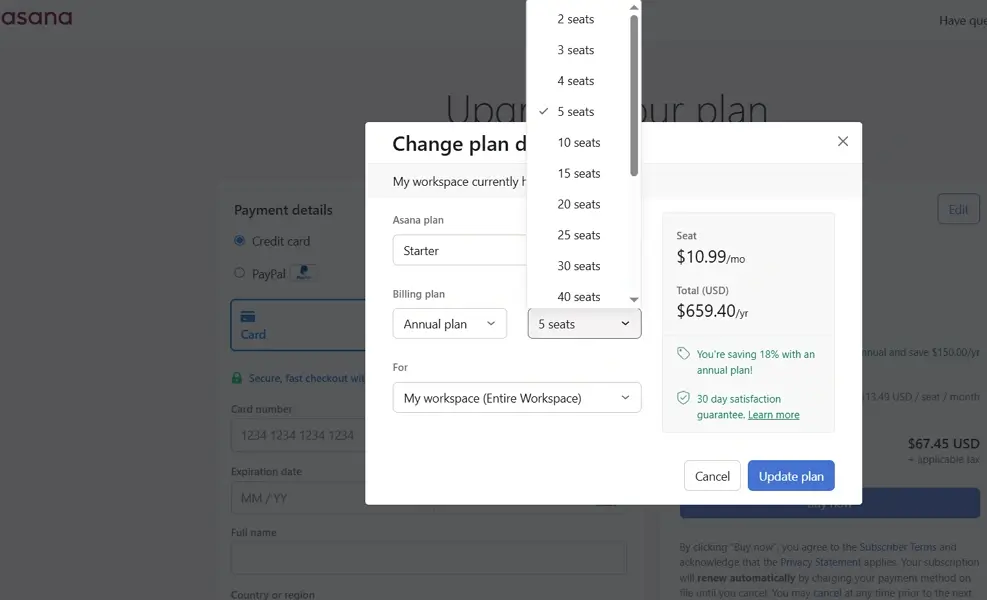
This detail isn’t made clear on the public pricing page. However, it only appears during the checkout process after account setup. This lack of upfront transparency can lead to unnecessary costs, making it a crucial factor for businesses to consider before committing to a plan.
Asana Pricing: A Detailed Explanation
Understanding the different Asana pricing structures is essential before committing to one. Each plan is structured for different needs, workflows, and specific team sizes. We’ll break down each plan in detail, outline pricing, features, and who it is best suited for.
Is Asana Free?
Yes. Asana still offers a free plan. The free plan offers some of the core project management features and is a good option for users who want to get started before committing resources.
Key Features:
- iOS and Android mobile apps
- Unlimited storage, 100MB max per file
- 100+ free integrations
- Unlimited projects
- Collaborate with up to 10 teammates
- Unlimited tasks
- Time tracking with integrations
- Activity logs
- Status updates
- List, board, and calendar views
- Basic search filters
- Unlimited messages
Limitations:
- Lacks advanced views like Gantt charts
- Basic reporting only
- No task dependencies
Compared to other project management software, Asana has one of the most generous free plans. Asana’s free plan allows unlimited storage, messages, projects, and tasks. In comparison, ClickUp — the best project management software — offers unlimited tasks but only 100MB of storage and limited messages.
This makes Asana’s free plan suitable for freelancers, startups, small teams, and individuals managing simple project management. However, if your work involves many dependencies, timelines, or requires robust reporting or security, you’ll likely outgrow the Free plan quickly.
Asana Starter Plan: Features and Limitations
Asana’s Starter plan is the cheapest paid tier at $10.99/user/month when billed annually or $13.49/user/month when billed monthly. The plan has a 14-day trial to allow users to test its premium features before making a financial commitment. It is designed for growing teams that need to track different tasks.
Key features:
- Asana AI: Use AI to generate smart summaries and suggestions, as well as automate routine work. This allows teams to get better insights and also get more time to focus on core business.
- AI Studio (with additional credits for purchase): The no-code builder in Asana AI Studio can capture, sort, and assign incoming requests. This creates more effective workflows and cuts down on time spent on repetitive tasks.
- Advanced search: Use advanced filters to search for files and get better insights of your projects. This saves on time and makes teams more productive.
- Custom fields: Add custom fields like budgets and estimates to suit your needs. Custom fields make it easy to personalize projects and make them relatable.
- Timeline and Gantt view: Get advanced project views like Timeline, where you get a timeline chart, task dependencies, and time overlap. Advanced views help teams get a clear view of their tasks and adjust timelines before things get out of hand.
- Workflow builder: Create ‘rules’ that automate repetitive tasks like assigning projects or setting project deadlines. This saves time, which means more time for core business.
- Project dashboards: View and customize dashboards with metrics like task progress, team workload, and overdue work. These dashboards give teams instant insights without switching tools.
- Universal reporting: Build and generate high-level reports across multiple projects to understand team performance, identify blockers, and make data-driven decisions.
Limitations:
- You may end up paying for unused seats due to tiered pricing
- No native time tracking
Asana Advanced Plan: Features and Limitations
Asana’s Advanced plan suits companies that want to manage different goals and portfolios across various departments. The plan costs $24.99 per user/month when billed monthly or $30.49/user/month when billed monthly.
Key features:
- Native time tracking: Track the number of hours you or your team members spend on various tasks without leaving Asana. This eliminates the need for a dedicated time tracking app.
- Scaled security: Enjoy advanced settings and permissions for larger organizations in this Advanced plan. This makes it easy to control who accesses what and when.
- Goals: Set up company goals and let team members see how their work connects to the overall vision.
- Forms branching and customization: Generate follow-up questions based on particular responses to multi-select questions or dropdowns.
- Approvals: Set up approval rules where certain tasks need to be approved and determine when. Automate complex workflows and reduce time wastage.
- Unlimited portfolios: Group projects into portfolios and make it easy to track progress or see a high-level status of your crucial projects.
- Workload: Assess your team’s workload, assign new tasks, or redistribute tasks to balance the load and ensure that no one is overburdened.
- Integrations with Salesforce, Tableau, and Power BI: Integrate with your favourite data visualization tools and make more informed decisions.
- Lock custom fields: You can lock custom fields so that only certain users can edit them.
Limitations:
- Steep learning curve as features increase
- Limits on usage like AI credits
Asana Enterprise Plan: Features and Limitations
Asana Enterprise plan is built for large and complex organizations that need rigorous control, automation, customization, and governance across departments or teams. Pricing for this tier is only available by quote.
Key features:
- 24/7 priority support: Get priority support at any time of the day for 7 days a week. This ensures that you can handle billing or technical issues fast and ensures your workflows aren’t interrupted.
- Workflow bundles: Create, update and apply processes across different projects within your organization. This saves on time and ensures consistency in your workflows.
- Team membership admin controls: Control who can access which files and who can assign tasks. This reduces confusion and makes team members accountable.
- SAML: Enforce SAML-based authentication like login via corporate identity provider. This centralizes credential management and reduces password errors.
- Mobile app controls: You can restrict how mobile apps users use Asana. For instance, set them to only view or comment on projects. This improves the security of your projects as mobile devices can land on the wrong hands.
- Expedited user set-up with SCIM: System for Cross-domain Identity Management (SCIM) allows automatic provisioning and deprovisioning of users through your identity provider. That means you don’t have to manually invite or remove users as everything is in sync with your corporate directory.
- Guest invite permissions: Control how guests can interact with your projects or tasks and what they can see. This ensures privacy and makes team members accountable for their actions.
- Admin announcements: Admins can publish organizational-wide announcements on your Asana workspace. This ensures that important updates reach all concerned parties in a timely manner.
- Service accounts: These accounts allow super admins to have complete access to all the data within their organization. They can also process the date via Asana API. This feature enhances governance.
- Project admin controls: You can assign specific team members with elevated privileges like assigning or approving projects. This reduces delays in project execution and makes members more accountable.
- Resource management: Check on resource allocation for various projects and even reallocate. This ensures that every team member is working to their best capacity and also reduces burnouts.
- Custom branding: Add logos and company colors to your workspace to make it more professional and aligned with your branding.
Limitations:
- Higher levels of control mean a steeper learning curve
- Higher configuration overhead
Asana Enterprise+ Plan: Features and Limitations
The Enterprise+ plan is the highest tier on Asana. You can expect the highest level of security, compliance, and administrative control offered by Asana. It suits highly regulated industries that manage complex projects, such as healthcare, finance, legal, and government. Just like the Enterprise plan, Enterprise+ is available only by quote.
Features:
- HIPAA Compliance: Asana tools are compliant with the Health Insurance Portability and Accountability Act of 1996 (HIPAA). This makes this project management platform suitable for organizations handling medical information.
- Managed workspaces: Admins can manage multiple workspaces under one platform. This centralizes governance and simplifies task management oversight.
- Data loss prevention integration support: This integration allows users to detect, monitor, and protect sensitive data. This allows organizations to meet regulatory requirements or beef up data loss prevention measures.
- Audit log API: Get a detailed report of user activities like login attempts, hours logged in, and data accessed. This ensures malicious incidents are detected on time and correct measures are initiated.
- eDiscovery integration support: Integration with eDiscovery solutions helps legal teams collect, preserve, and export data for litigation or regulatory investigations. This is crucial for compliance in the finance, legal, and healthcare sectors.
- Archiving integration support: Organizations can integrate with various data archiving tools. This enables automated archiving of project and task data for long-term storage, regulatory compliance, or internal retention policies.
- Data residency: Enterprise+ customers can choose where to store their data in data centers in the US, Japan, Ireland, or Australia. This adds an extra layer of security and ensures compliance with the General Data Protection Regulation (GDPR).
- Enterprise Key Management: Organizations maintain control over their encryption keys, enabling them to rotate, revoke, or manage access independently of Asana. This adds an extra layer of security and compliance.
- Trusted guest domains: Enterprise+ subscribers can restrict external collaborators to specific, pre-approved email domains to prevent data exposure. This is essential for companies working with multiple partners or vendors.
- App management: Enterprise+ plan gives admins centralized control over which apps and integrations are approved, blocked, or managed within the organization. This minimizes security risks from unauthorized third-party tools.
- Custom branding: Add logos and company colors to your workspace and make it more relatable.
Limitations:
- Higher overhead costs
- Steeper learning curve
How to Start Asana’s Free Trial: A Step-by-Step Guide
Asana offers a 14-day free trial on its Starter and Advanced tiers. Below, I’ll show you how to get Asana free trial and enjoy premium task management features without paying anything.
Step 1: Sign up on Asana
To get started with Asana, head to the homepage and click “Get started”.
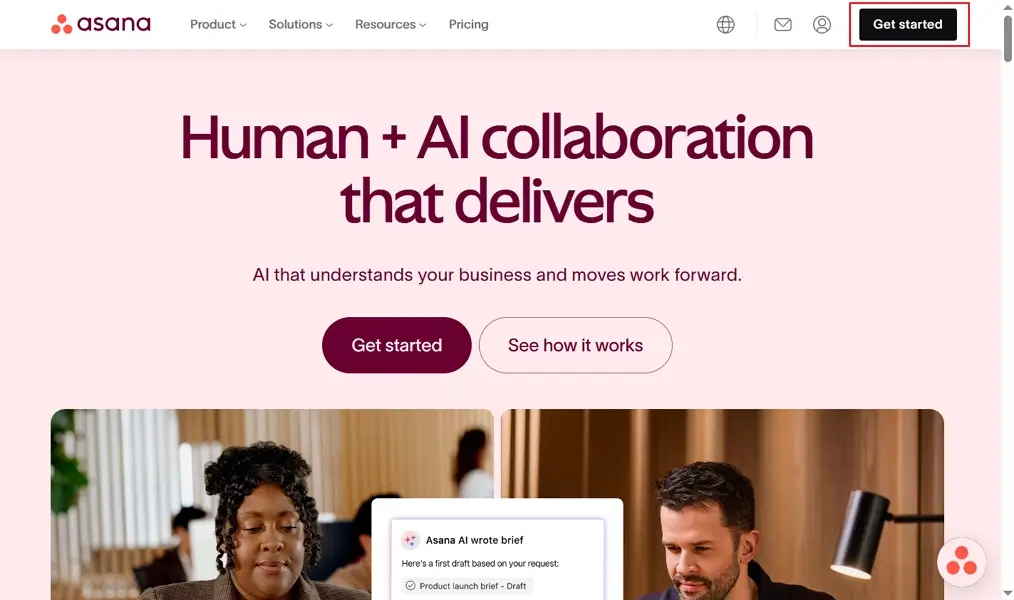
Step 2: Create a free account
Follow along with the signup wizard to create a free account. You can either sign in with your organizational account or use your Google account to sign up.
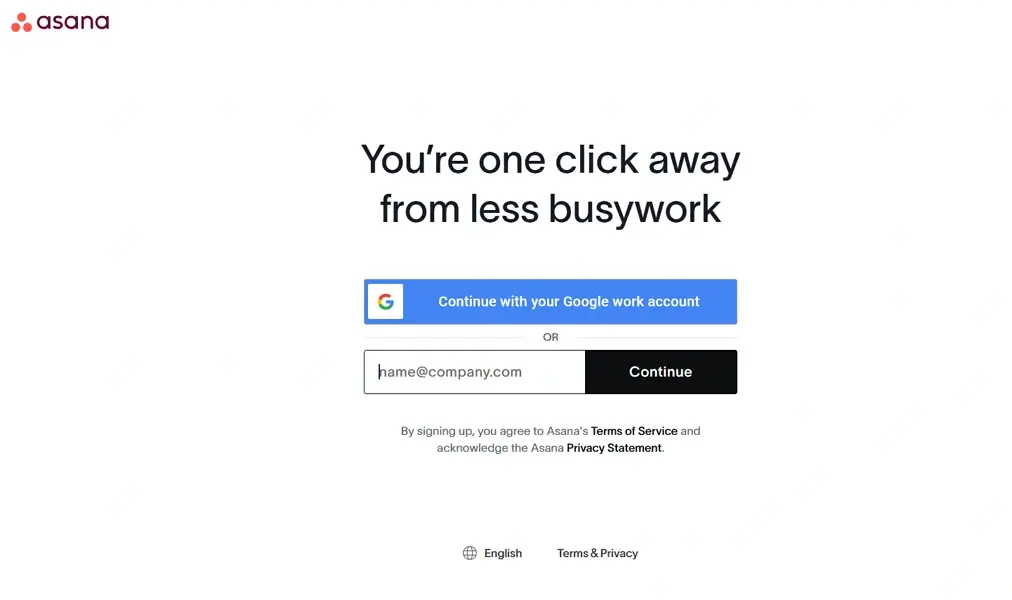
Step 3: Enjoy Free Trial for 14 Days
Asana automatically gives a 14-days free trial after signing up. The good news is that you don’t have to add a billing method to enjoy this free trial. This enables you to test all premium features risk-free.
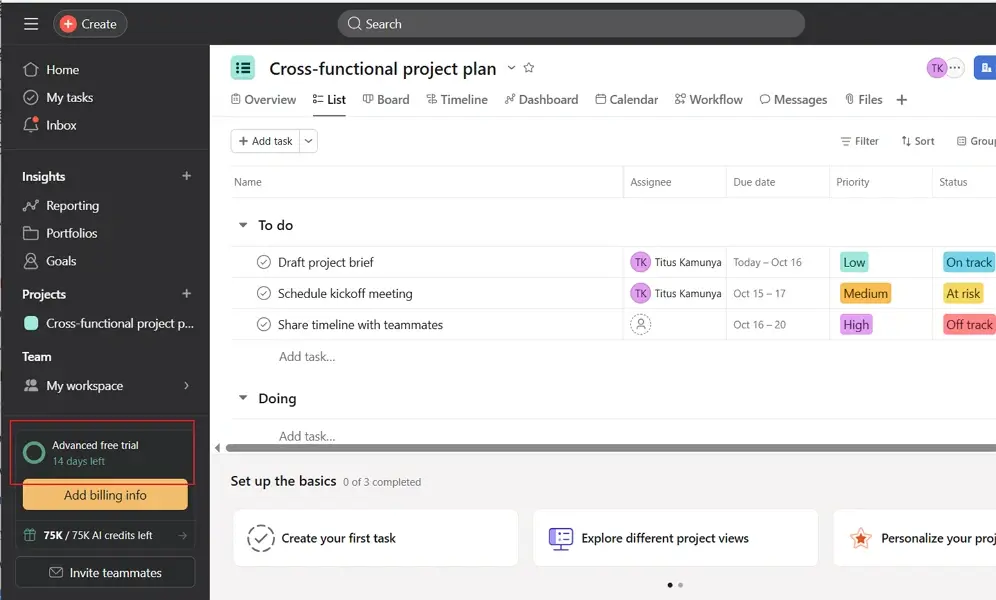
Conclusion: Does Asana Offer Value for Your Money?
Asana is one of the most trusted project management software platforms as it offers the right balance between simplicity and powerful functionality. Its Free plan is ideal for individuals, freelancers, and small teams looking to collaborate seamlessly, and manage unlimited tasks without paying a dime. It’s a perfect entry to explore Asana’s capabilities before investing in premium features.
The paid plans — Starter, Advanced, Enterprise, and Enterprise+ — unlock deeper functionalities like workflow automation, portfolio tracking, and enterprise-level security. Moreover, Asana scales efficiently to match your needs. Although this project management software is pricier than competitors like ClickUp or Trello, the trade-off comes in robust integrations, usability, and reliability for large, complex teams. if you are looking for a more cost-effective solution, Check out our ClickUp pricing guide today.
So, is Asana worth it? If you’re seeking a scalable, easy-to-use, and feature-rich project management software that grows with your organization, Asana is a smart investment. It empowers teams to plan better, collaborate faster, and deliver projects efficiently. Furthermore, it has different pricing plans with varying features to suit different needs.
How much does Asana cost?
Asana’s paid pricing plans start at $10.99 per user/month (billed annually) for Starter and $24.99 per user/month for Advanced. Enterprise and Enterprise+ have custom pricing available upon request.
Is the free version of Asana worth it?
Yes. Asana’s free plan is a strong option for individuals, freelancers, and small teams. It includes unlimited tasks, projects, and basic task management and collaboration features.
Is Asana cheaper than Jira?
No. Jira’s pricing starts at $6.53 per user/ month, while Asana’s plans start from $10.99 per user/month.

